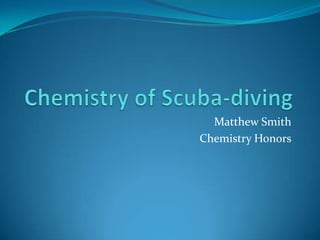Chemistry of scuba diving ppt
- 2. Brief Information Allstaractivities.com ŌĆó Scuba-diving is an underwater hobby. ŌĆóTo scuba-dive, one must become certified through classes and hands-on-training through the organization PADI (Professional Association of Diving Instructors). ŌĆóMajor equipment of a scuba-diverŌĆÖs gear is their regulator, tank, and BCD. The regulator and tank are used for breathing and the BCD controls buoyancy. ŌĆóThe NUMBER ONE rule of scuba-diving is DO NOT hold your breath.
- 3. Chemistry ’éŚ BoyleŌĆÖs Law- is an inverse relationship of pressure and volume. As volume decreases, pressure increases, or inversely (Belleman 5). P1V1=P2V2 ’éŚ When divers descend below sea level, they are adding more pressure than normal atmospheric pressure. (1 atm) ’éŚ When we go to the bottom of a pool, we feel a lot of pressure. How are we able to withstand depths up to 30 feet?
- 4. BoyleŌĆÖs Law Continued Nurse Shark ŌĆóWhen scuba-diverŌĆÖs dive, the tank that supplies the oxygen, gives it at the same pressure as the surrounding pressure (Belleman 5.) ŌĆóAs stated earlier, the most important rule of scuba-diving is to not hold your breath. Why? ŌĆóThe pressure on us while diving causes cavities in our body that contains air to be compressed. ŌĆóIf we hold our breath and expand our lungs but do not breathe out, the pressure can cause damage to our lungs and can burst lung sacs (Belleman 5).
- 5. Ascending with BoyleŌĆÖs Law ’éŚ When a diver ascends to the surface, the pressure is decreased which causes the volume of gas in our cavities to expand. ’éŚ That is why divers ascend in increments to lessen the risk of over expanding the lungs (Wood 1). Asset.emsofl.com
- 6. HenryŌĆÖs Law/The Bends ŌĆóHenryŌĆÖs Law- the solubility of gas is directly linked to pressure (Belleman 6). ŌĆóThis means that as a diver descends gases dissolve more easily into our body than at normal atmospheric pressure. ŌĆóNitrogen is a gas that is found in normal breathing air. ŌĆóWhen a diver descends, nitrogen dissolves into our body more easily. Lionfish
- 7. Decompression Sickness ’éŚ If divers ascend to fast, not only may strain occur to the lungs due to BoyleŌĆÖs Law, but nitrogen bubbles may form which cause the ŌĆ£BendsŌĆØ or Decompression Sickness (Belleman 6). ’éŚ The ŌĆ£BendsŌĆØ occurs when the pressure is released too fast on ascension and the nitrogen gas bubbles escape (Wood 1). ’éŚ Decompression sickness can cause pain to the spinal cord and the muscles (David, Kulkarni, Phatak 1). Also death could occur.
- 8. Implications Understanding the gas laws helps us understand how to protect ourselves while scuba-diving. Sharkcagediving.blogs pot.com Dive-n-log.com Knowing how pressure affects our bodies, we can know how our scuba equipment helps us dive to large depths.
- 9. Works Cited ’éŚ Belleman, Mellisa, and Tim Graham. "Gas Laws and Scuba Diving." ChemMatters Feb. 2001: 4+. ACS. Web. 13 Apr. 2014. ’éŚ David, Eric, Pravin Kulkarni, and Uday Phatak. "Decompression syndrome (Caisson disease) in an Indian diver." Annals of Indian Academy of Neurology 13.3 (2010): 202. General Science Collection. Web. 13 Apr. 2014. ’éŚ Wood, Mary. "Boyle's and Charles' laws: a load of hot air?" Chemistry Review Sept. 2009: 8+. General OneFile. Web. 28 Apr. 2014.








